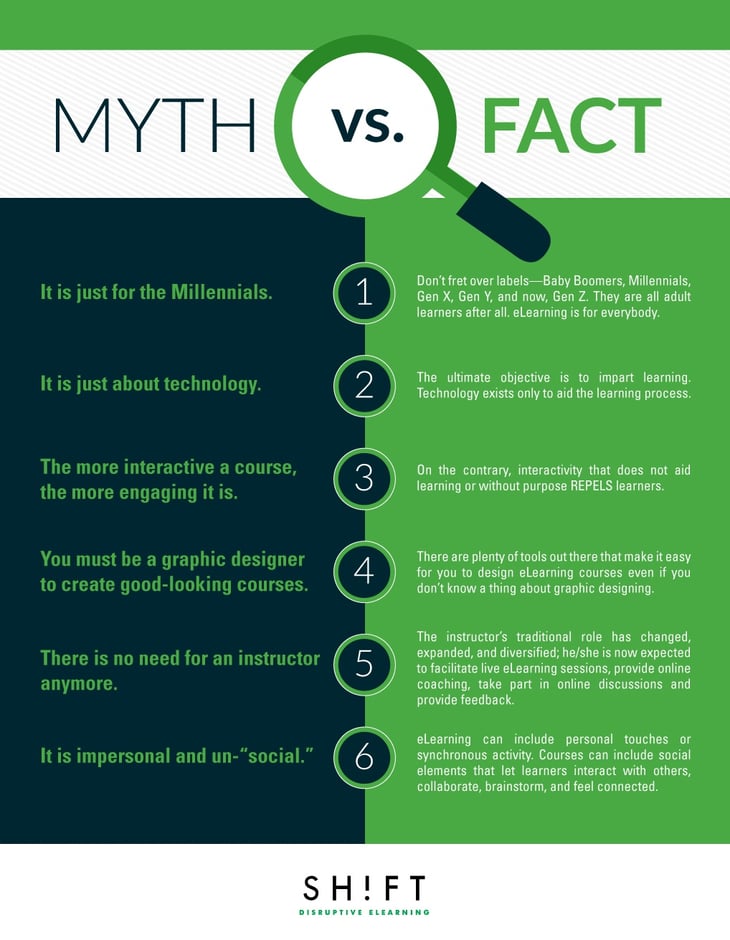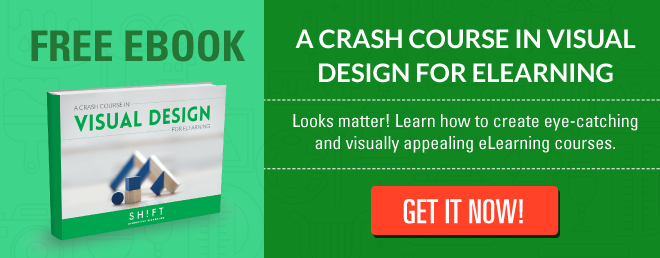As the corporate world transitions from the four walls of the classroom to a more open virtual world, instructional designers are beginning to discover innovative ways to make eLearning work for learners. However, for many designers out there, it is still something “alien” that they view with excitement and curiosity mixed with trepidation.
As it is with any nascent tool or trend, eLearning too is shrouded in myths. The sooner these eLearning myths are busted, the easier it would be for designers to conceive and create courses that provide value to wider audiences.

Myth #1: It is just for the Millennials
No, eLearning is for everybody.
Blame the media for showing the Baby Boomers in poor light—bumbling and fumbling as they try to wrap their wits around smartphones and laptops. While it is true that some Baby Boomers wish they can wish away the screens, keyboards, and styluses, most others are sensible, intelligent folks who realize that eLearning gives them easy, on-demand access to knowledge. Most importantly, Baby Boomers at the workplace realize that eLearning helps them do their jobs more efficiently, so they are eager to take digital courses.
Right now, eLearning is one of the most effective training strategies that are around. You just can’t dispute these facts.
Advances in digital technology have made it possible to create and deliver effective eLearning courses more easily and cost-effectively. So there’s no reason why you should create courses only for the younger learners and keep Baby Boomers away from the benefits of eLearning.
Here’s a tip: Don’t fret over labels—Baby Boomers, Millennials, Gen X, and now, Gen Z. They are all adult learners after all. Find out what motivates adult learners and keep in mind these rules of creating effective adult learning.
Myth #2: It is just about technology
Wrong! First comes the learning. Technology comes second.
The ultimate objective of a training program is to impart learning. Technology exists only to aid the learning process.
The content determines how effective and appealing an eLearning course is. It is the content that addresses “why” and “what” to learn. Technology is about “how” to deliver the learning. The more compelling the “why” and the “what,” the more the number of learners who will want to take the course.
Keep the following tips in mind to strike the right balance between content and technology:
- Do not prioritize technology. Focus on creating content that connects with the learning and engages the learners. Here are 10 ideas.
- Don’t let technology come in the way of delivering effective learning. Use technology ONLY if it enriches the learning experience.
- Think twice before using new or complex technology just because it sounds “cool.” You wouldn’t want learners to expend their cognitive energy wondering how the technology works before they get to the learning.
Only technology cannot create “engaging” content, and this brings us to the next myth.
Myth #3: The more interactive a course, the more engaging it is
On the contrary, interactivity that does not aid learning or without purpose REPELS learners.
Think about your favorite movie or book. You didn’t keep clicking to watch the movie. Nor did the characters in the story pop out of the pages to throw questions at you. But were you not hooked? Were the scenes, actions, and passages less engaging because you didn’t “interact” with the interface? NO.
While it is true that interactivities increase the engagement quotient of an eLearning course, it is also easy to go OTT with them and kill the course. There is a fine line between enhancing the instructional soundness of your course with interactivities and ending up overwhelming the learner with too many goings-on. Too many interactivities can distract from the learning; this defeats the purpose of the course.
Keep these in mind when you design an interactive course:
- Include interactivities that simplify the learning process. For instance, a show-and-tell mode of interactivity is ideal to prevent text overload or to break down complex concepts and graphics to explain each component.
- Include interactivities that hook learners to the course. For instance, a show-and-try mode of interactivity provides learners with the opportunity to explore and discover the learning themselves. This is definitely a hook for the adult learner who wants to figure things out for himself.
- Avoid bells and whistles.
- Make sure that the interactivities integrate seamlessly with the content. More clicks are NOT always merrier, especially when interactivities disrupt the flow of a story or the logical progression of events. For instance, the Next button may sometimes do more harm than good.
- Include relevant interactivities. For instance, don’t include unnecessary levels in content drill-down type interactivities. Group chunks of related content on the same level even it means you have to do away with a few clicks.
- Think simply. Sometimes simple interactivities that enable learners to maintain a lively pace of learning are more effective than flashy, complex, multi-tiered interactivities that make you click endlessly without revealing much information.
- Always remember this: Interactivity is NOT entertainment.
Myth #4: You must be a graphic designer to create good-looking courses
Thankfully, this is no longer true. You can now focus on creating stellar storyboards, realistic scenarios, compelling stories, intriguing characters, and punchy prose without worrying about how your course will look after you add your amateur artistic touches.
There are plenty of tools out there that make it easy for you to design eLearning courses even if you don’t know a thing about graphic designing. Powerful eLearning authoring tools, like SHIFT, also have built-in functionalities to help you design courses.
Also, if you want to learn some design, there are plenty of resources—both free and subscription-based—on the Internet to help you out with the theories, techniques, tools, trends, tricks, and best practices. Meanwhile to get you started, here are some DIY eLearning graphic design tips.
Myth #5: With eLearning there is no need for an instructor anymore
This myth has been around since the time eLearning came about. But it is easy to understand why the confusion abounds; after all, it is indeed hard to figure out where the instructor features in a course that is delivered online. It is now time to dispel the doubts once and for all.
The instructor’s traditional role has changed, expanded, and diversified; he/she is now expected to facilitate live eLearning sessions, provide online coaching, take part in online discussions, manage courses by organizing and formatting instructional material to suit independent study and digital delivery, and provide feedback on work submitted by learners over video chats and email. Many eLearning course facilitators even set up office-hour blocks to meet students and provide supplementary coaching, guidance, feedback, and mentoring.
Myth #6: It is impersonal
According to Albert Bandura’s Social Learning Theory, people learn more effectively when they observe others in their environment and model their behavior on the actions of those people that they believe are achievers. When learning takes place without human interaction and in a solitary environment, learners tend to get demotivated. Some take it easy and may tend to slack off. For those who went through the traditional classroom training system, the mere belief that eLearning is a lonesome pursuit is enough to keep them away from taking an online course.
What is more, as Jane Hart says, learning in the modern workplace takes place both through online courses and social collaboration. Think how you work. You go through training programs, but you also pick up skills, tips and tricks of the trade, and job hacks from your peers and by watching your seniors at work.
There was a time when eLearning courses were impersonal, unsocial, and solitary experiences. But not now.
Instructional designers today create courses with social elements that let learners interact with others, collaborate, brainstorm, and feel connected. In fact, collaboration and brainstorming with peers have been proven to be effective learning practices that place learning into context, encourage learners to think laterally, and learn how to assimilate diverse strands of information to absorb knowledge, find answers, and discover solutions.
Here’s how you can add socialization in your eLearning courses:
- Create courses that let learners interact with facilitators and other participants. You can include features like email, chat, video, and discussion boards to facilitate such interactions.
- Create courses with features like team tasks and group projects that encourage learners to communicate with one another and collaborate. Include features like threaded discussions that encourage learners to share ideas.
- Explore the scope of existing technology. For instance, many LMSs integrate news forums.
- Consider integrating your course with third-party but closed social channels like Yammer or with private groups on existing social platforms like Facebook.
When you can see through the myths of eLearning, you can exploit the true scope of this powerful learning format.



